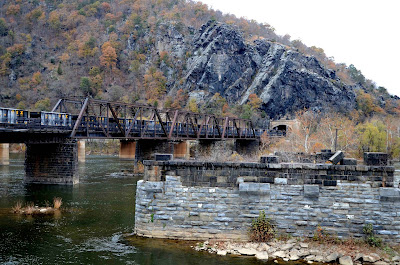After lunch and phase one of conversing, we drove to Harper’s Ferry NP to meet our guide. Jim, divided our tour into three parts, the town’s role during the Civil War, the battles fought in this area and John Brown (the part of the story that is best known).
Harper’s Ferry and the adjacent Bolivar Heights are at the confluence of the Potomac and Shenandoah Rivers.
They are adjacent to Maryland, West Virginia and Virginia . The view, somewhat clouded over on our visit, covered all three states.
At the time of the Civil War, the hills were denuded of trees to provide a clear field for rifle and cannon fire.
Back in the early 1700s few settlers lived in the area. One settler ran a rickety ferry boat across the Potomac. Robert Harper came to the area and bought that ferry service along with 120 acres of land The town was then named Shenandoah Falls at Mr. Harper’s Ferry. George Washington chose the area to build an armory for the construction of rifles, which made the town prosperous then vulnerable. The armory was 600 yards long and made weapons with interchangeable parts, a revolution at that time. Merriweather Lewis got rifles for the Corps of Discovery in his journey across the continent.
When the Civil War broke out, the position of the town along the two rivers and surrounded by mountains made it the most fought-over area in the war. More than 1300 battles were fought on land that kept changing hands. Early in the war, twelve thousand Union troops surrendered to Thomas (Stonewall) Jackson. Toward the end of the war, U. S. Grant burned the area to clear it of Confederate Troops.
The event that has made Harper’s Ferry a well-known part of history occurred in 1859. John Brown was a strong and vocal opponent abolitionist. He railed against it in churches.
He was sure that he could get the slaves to rise up and follow him. Along with twenty-one followers, his plan was to attempt to seize the arsenal where over 100,000 rifles made at the armory were stored and distribute the weapons to slaves. This is all that remains of the arsenal.
His thirty-six-hour raid failed and he, along with most of his men, were either shot in the battle or hung. Union soldiers later destroyed the armory rather than risk the weapons being used by the rebels.
The John Brown Museum that tells his story in three parts while viewers sit first on church pews, then on rifle boxes and lastly in a jury box.
Following his execution Southern anger increased while Northerners revered him. Brown’s actions helped rip the North and South apart and helped Lincoln get elected. Our guide theorized a formula that Brown led to Lincoln which led to Civil War. He posed a question: Was Brown a hero or a terrorist?
Following our guided tour we climbed the narrow street of Harper’s Ferry seeing the remaining stone buildings, some displaying artifacts of earlier times or information about wildlife in the area.
Above town was the site of Storer College (1867 - 1954) which was open to all students, regardless of color or gender. At that time, in the South, it was still illegal to teach former slaves to read or write.
Robert Harper did not live to enjoy his home on a knoll above town.
This railroad bridge has been in operation since before the Civil War.
The steps to the church are carved into the rock.
We all had a great time learning history, seeing the sights and, mostly, conversing.












No comments:
Post a Comment